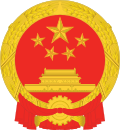
Back Kampagne zur Unterdrückung von Konterrevolutionären German Campaña para suprimir contrarrevolucionarios Spanish کمپین سرکوب ضدانقلابیان Persian Campagne pour réprimer les contre-révolutionnaires French Kampanye untuk Menindas Kontra Revolusioner ID Campagna per la soppressione dei controrivoluzionari Italian Campagne voor de onderdrukking van contrarevolutionairen Dutch Campanha de repressão aos contrarrevolucionários Portuguese Kampaň za potlačenie kontrarevolucionárov Slovak Kampanja za zatiranje protirevolucionarjev Slovenian
| Campaign to Suppress Counterrevolutionaries | |||
|---|---|---|---|
| 鎮壓反革命運動 Part of the Cold War in Asia | |||
 A poster promoting the campaign, 1951 | |||
| Date | 1950–1953[1] | ||
| Location | China | ||
| Methods | |||
| Resulted in | |||
| Parties | |||
| |||
| Number | |||
| |||
| History of the People's Republic of China |
|---|
 |
|
|
The Campaign to Suppress Counterrevolutionaries (Chinese: 鎮壓反革命運動; pinyin: zhènyā fǎngémìng yùndòng, abbreviated as 鎮反; zhènfǎn) was the first campaign of political repression launched by the People's Republic of China designed to eradicate opposition elements, especially former Kuomintang (KMT) functionaries accused of trying to undermine the new Chinese Communist Party government.[1] It began in March 1950 when the Central Committee of the Chinese Communist Party issued the Directive on elimination of bandits and establishment of revolutionary new order (Chinese: 剿滅土匪,建立革命新秩序), and ended in 1953.[7][8]
The campaign was implemented as a response to the rebellions that were commonplace in the early years of the People's Republic of China. Those targeted during the campaign were thereafter labeled as "counterrevolutionaries", and were publicly denounced in mass trials. Significant numbers of "counterrevolutionaries" were arrested and executed and even more sentenced to "labor reform" (Chinese: 勞動改造; pinyin: láodòng gǎizào).[9] According to the official statistics from the Chinese Communist Party (CCP) and the Chinese government in 1954, at least 2.6 million people were arrested in the campaign, some 1.3 million people were imprisoned, and 712,000 people were executed.[8][10] Scholars and researchers either accept the numbers of the executions,[2] or give their own estimates ranging from 500,000 to 1 or 2 million.[4][5]
- ^ a b Cite error: The named reference
Yang Kuisongwas invoked but never defined (see the help page). - ^ a b c d Guo, Xuezhi (2012-08-29). China's Security State: Philosophy, Evolution, and Politics. Cambridge University Press. p. 62. ISBN 978-1-107-02323-9.
Among them, 712.000 counterrevolutionaries were executed, 1.29 million were imprisoned, and 1.2 million were subject to control at various times.
- ^ Changyu, Li. "Mao's "Killing Quotas." Human Rights in China (HRIC). 26 September 2005, at Shandong University" (PDF). Archived from the original (PDF) on 29 July 2009.
- ^ a b MacFarquhar, Roderick (1997). The Politics of China: The Eras of Mao and Deng. Cambridge University Press. p. 37. ISBN 978-0-521-58863-8.
But the primarily urban campaign against counterrevolutionaries may have resulted in as many as 500,000 to 800,000 deaths (see Stavis, The politics of agricultural mechanization, 29).
- ^ a b Maguire, Edward R.; Brookman, Fiona; Maguire, Mike (2017-03-29). The Handbook of Homicide. John Wiley & Sons. p. 470. ISBN 978-1-118-92448-8.
Other scholars put the number of executed people during the Campaign to Suppress Counterrevolutionaries between 1 million and 2 million (Dikotter 2013: 83; Pye 1991: 235; Strauss: 2002: 87).
- ^ "鎮壓反革命運動". Archived from the original on 2018-07-31. Retrieved 2018-07-31.
新中國成立后,國民黨有計劃地潛伏和殘留在大陸上的土匪、惡霸、特務、反動黨團骨干、反動會道門頭子和其他反革命分子約有300余萬人
- ^ Strauss, Julia C. (2002). "Paternalist Terror: The Campaign to Suppress Counterrevolutionaries and Regime Consolidation in the People's Republic of China, 1950-1953". Comparative Studies in Society and History. 44 (1): 80–105. doi:10.1017/S001041750200004X. ISSN 0010-4175. JSTOR 3879401. S2CID 144001444.
- ^ a b Huang, Zhong (2014). "第一次镇反运动考察(含注释)". Yanhuang Chunqiu (12). Archived from the original on 2020-09-21.
- ^ Brown, Jeremy. "Terrible Honeymoon: Struggling with the Problem of Terror in Early 1950s China.". Archived from the original on 2009-06-27.
- ^ "新中国成立初期大镇反:乱世用重典(8)". Renmin Wang (in Chinese). 2011-01-04. Archived from the original on 2020-06-15. Retrieved 2020-02-17.

